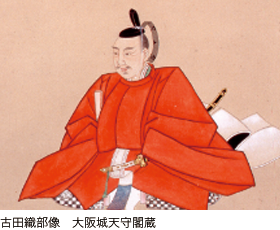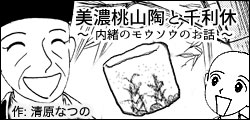
- 美濃の窯 ▽
Kilns Used to Fire Mino Ware - 美濃桃山陶 ▽
Momoyama-period Mino Ware -
可児市収蔵品
Kani Collections -
美濃焼の基本作陶法[video]
Basic work pottery method of Mino -
戦国武将と茶陶 ▽
Warlords and Tea Utensils-
織田信長の名物狩りと茶の湯御政道
ODA Nobunaga’s Gathering of Famous Tea Utensils and the Politics of Tea -
美濃金山城主森家と茶の湯
The MORI Family, Lords of Mino-Kaneyama Castle, and their Involvement with the Tea Ceremony -
豊臣秀吉と北野大茶湯
TOYOTOMI Hideyoshi and the Kitano Grand Tea Ceremony -
千利休と戦国武将
SEN no Rikyū and Warlords -
古田織部と茶陶
FURUTA Oribe and Ceramic Utensils for the Tea Ceremony
-
織田信長の名物狩りと茶の湯御政道
-
荒川豊蔵
ARAKAWA Toyozō -
加藤孝造
KATŌ Kōzō -
可児市の作陶家
Potters of kani city
企画のご案内
発掘調査
・発掘調査報告[6件]
古田織部と茶陶 FURUTA Oribe and Ceramic Utensils for the Tea Ceremony
 古田織部は、戦国時代から江戸時代初期に活躍した武将
で、美濃(今の岐阜県本巣市といわれている)に生まれまし
た。一般的には、武将茶人として知られています。「織部」
の名は、従五位下織部正に叙されたことに由来しています。
利休七哲の一人とうたわれた古田織部は、秀でた数寄者であり、「破調の美」を確立させた芸術家としての一面もみられます。利休亡き後の茶頭として、千利休が大成した侘び茶を継承しつつ、大胆かつ自由な気風を好み、茶道具の制作や建築、作庭を行い、「織部好み」や「へうげもの(ふざけるとかひょうきん)」といわれる一大流行を、安土桃山時代にもたらしました。
古田織部は、戦国時代から江戸時代初期に活躍した武将
で、美濃(今の岐阜県本巣市といわれている)に生まれまし
た。一般的には、武将茶人として知られています。「織部」
の名は、従五位下織部正に叙されたことに由来しています。
利休七哲の一人とうたわれた古田織部は、秀でた数寄者であり、「破調の美」を確立させた芸術家としての一面もみられます。利休亡き後の茶頭として、千利休が大成した侘び茶を継承しつつ、大胆かつ自由な気風を好み、茶道具の制作や建築、作庭を行い、「織部好み」や「へうげもの(ふざけるとかひょうきん)」といわれる一大流行を、安土桃山時代にもたらしました。利休の大成した「侘び茶」に対し、織部の茶の湯は開放的かつ躍動感に満ちていました。利休は簡素で飾り気のない黒楽茶碗を好んだのに対し、織部は一見いびつとも思える揺らぎの美を秘めた志野や織部を好みました。このようなことから、利休好みの「静」に対し、織部好みの「動」と表現されます。
また、利休は狭く暗い二畳の茶室を造ったのに対し、織部は光が降り注ぐように多くの窓を取り入れた茶室を造りました。
織部が活躍した安土桃山時代は、新しい価値観が次々と生まれた変革の時代です。時代の風潮から、建築や絵画などに華やかな文化が生まれます。また、町には奇抜な格好やふるまいをする「かぶき者」と呼ばれる人々があふれていました。そうした時代の精神を茶の湯に取り入れたのかもしれません。
FURUTA Oribe was a famous general who was born in Mino Province (he is said to have been from the present day Motosu City in Gifu Prefecture) and was active from the fifteenth to early sixteenth centuries. He is well-known for having been both a general and a tea master. The name ‘Oribe’ comes from a rank awarded by the Court. Apart from being one of Rikyū’s ‘seven disciples’, Oribe was also artistically inclined and developed the concept of the ‘aesthetics of discord’. After the death of Rikyū, he became the leading tea master, inheriting Rikyū’s wabicha-style, but enjoying a bold, free temperament, he produced his own tea utensils, buildings and gardens, creating what became known as ‘Oribe taste’. These became extremely popular and ushered in the fashions of the Azuchi-Momoyama period (1573-1603).
In contrast to the wabicha-style established by Rikyū, Oribe’s tea ceremony was much more open, and vibrant. Whereas Rikyū favored plain black Raku tea bowls, Oribe preferred Shino or Oribe bowls that at first glance appear distorted and imbued with a fluctuating beauty. As a result, Oribe’s taste is expressed as being ‘dynamic’ as opposed to Rikyū’s that is considered ‘static’.
In a similar way, although Rikyū promoted the use of a small, gloomy, tearoom, two mats in size, Oribe preferred to build his with lots of windows, allowing the light to flood in.
The Azuchi-Momoyama period when Oribe was active was a revolutionary time, when new values were adopted in rapid succession. The trends of the times led to the creation of a flamboyant culture that gave birth to new forms of architecture and painting. It was a time when the towns were filled with kabukimono—people who wore strange garments and behaved in unusual ways—and it may have been in order to meet the demands of these times that this new form of tea ceremony appeared.
In contrast to the wabicha-style established by Rikyū, Oribe’s tea ceremony was much more open, and vibrant. Whereas Rikyū favored plain black Raku tea bowls, Oribe preferred Shino or Oribe bowls that at first glance appear distorted and imbued with a fluctuating beauty. As a result, Oribe’s taste is expressed as being ‘dynamic’ as opposed to Rikyū’s that is considered ‘static’.
In a similar way, although Rikyū promoted the use of a small, gloomy, tearoom, two mats in size, Oribe preferred to build his with lots of windows, allowing the light to flood in.
The Azuchi-Momoyama period when Oribe was active was a revolutionary time, when new values were adopted in rapid succession. The trends of the times led to the creation of a flamboyant culture that gave birth to new forms of architecture and painting. It was a time when the towns were filled with kabukimono—people who wore strange garments and behaved in unusual ways—and it may have been in order to meet the demands of these times that this new form of tea ceremony appeared.
